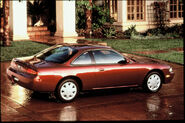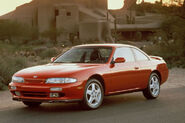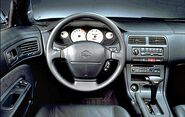No edit summary Tag: rte-wysiwyg |
(Adding categories) |
||
| (4 intermediate revisions by 2 users not shown) | |||
| Line 5: | Line 5: | ||
|bodystyle=2DR Coupe<br>2DR Convertible (until 1994) |
|bodystyle=2DR Coupe<br>2DR Convertible (until 1994) |
||
|transmission=5-speed manual |
|transmission=5-speed manual |
||
| + | |dimensions=177.2" x 68.1" |
||
|cylinders=4 |
|cylinders=4 |
||
|enginesize=2.4 liters |
|enginesize=2.4 liters |
||
| Line 11: | Line 12: | ||
|mpg=22/28 |
|mpg=22/28 |
||
}} |
}} |
||
| − | Since 1994, Nissan was the sole Japanese producer of a front-engined, rear-wheel drive sport coupe. The Toyota Celica (first Japanese import in this category), Honda Prelude, Acura Integra and Mazda MX-6 |
+ | Since 1994, [[Nissan]] was the sole Japanese producer of a front-engined, rear-wheel drive sport [[coupe]]. The [[Toyota Celica]] (first Japanese import in this category), [[Honda Prelude]], [[Acura Integra]] and [[Mazda MX-6]] were now all front-wheel drive. Think of the 240SX as a small T-Bird and you won't be too far off. Emphasis has moved away from sports car performance to making the vehicle more convenient and luxury. |
==Year-to-year changes== |
==Year-to-year changes== |
||
===1994=== |
===1994=== |
||
| − | Only a convertible remained for 1994. |
+ | Only a [[convertible]] remained for 1994. |
===1995=== |
===1995=== |
||
| − | For 1995, wheelbase and track |
+ | For 1995, wheelbase and track both increased, overall length fractionally decreased and weight was up slightly. Nissan dropped the fastback and convertible versions and concentrated on an all-new notchback body shell using a refined version of last year's drivetrain, Nissan claimed less vibration, lower noise levels and lower emissions compared with 1994. |
| − | New SE instruments |
+ | New SE instruments were electroluminescent with an appearance similar to those in the Lexus LS 400, extremely legible with red needles standing in sharp relief against a white background. |
| − | Both the base Coupe and upmarket SE |
+ | Both the base Coupe and upmarket SE had the same driveline and basic suspension, the SE added a rear anti-sway bar and 16-in. wheels, as well as the option of ABS/limited slip. |
| − | Standard equipment on the base Coupe |
+ | Standard equipment on the base Coupe included power steering, power brakes, a 50-watt AM-FM cassette stereo, tinted glass, power mirrors, power windows, rear-window defroster. A 160-watt, 6-speaker stereo was optional in the Coupe, standard on the SE. The SE had optional power sunroof and leather seating surfaces. |
| − | The 240SX, Coupe and SE, |
+ | The 240SX, Coupe and SE, were practical cars, well balanced, with excellent torque, handsome looks. Nissan has avoided trendiness and produced a usable car just one step removed from the practicality of a sedan. |
The January 1994 issue of Popular Mechanics magazine announced the 1995 240SX for a Spring release in dealerships. The car was officially released on April 18, 1994, when it joined the 1994 convertible. |
The January 1994 issue of Popular Mechanics magazine announced the 1995 240SX for a Spring release in dealerships. The car was officially released on April 18, 1994, when it joined the 1994 convertible. |
||
| Line 47: | Line 48: | ||
*'''$22,249 '''(1996 Nissan 240SX SE) |
*'''$22,249 '''(1996 Nissan 240SX SE) |
||
==Gallery== |
==Gallery== |
||
| − | |||
<gallery> |
<gallery> |
||
| − | |||
95240sx.jpg|1995 Nissan 240SX 2-door coupe |
95240sx.jpg|1995 Nissan 240SX 2-door coupe |
||
| + | 1995 Nissan 240SX SE 2DR Coupe.jpg|1995 Nissan 240SX SE |
||
| − | |||
| − | + | 6084CPMN.png|1996 Nissan 240SX 2-door coupe |
|
| + | 6085CPMN.png|1996 Nissan 240SX SE |
||
| − | |||
240sx_steeringwheel.jpg|The steering wheel of the Nissan 240SX |
240sx_steeringwheel.jpg|The steering wheel of the Nissan 240SX |
||
| − | |||
</gallery> |
</gallery> |
||
[[Category:Nissan]] |
[[Category:Nissan]] |
||
[[Category:2-door coupes]] |
[[Category:2-door coupes]] |
||
[[Category:2-door convertibles]] |
[[Category:2-door convertibles]] |
||
| + | [[Category:4-cylinder vehicles]] |
||
| + | [[Category:Mid-size cars]] |
||
Latest revision as of 15:43, 31 August 2021
Since 1994, Nissan was the sole Japanese producer of a front-engined, rear-wheel drive sport coupe. The Toyota Celica (first Japanese import in this category), Honda Prelude, Acura Integra and Mazda MX-6 were now all front-wheel drive. Think of the 240SX as a small T-Bird and you won't be too far off. Emphasis has moved away from sports car performance to making the vehicle more convenient and luxury.
Year-to-year changes[]
1994[]
Only a convertible remained for 1994.
1995[]
For 1995, wheelbase and track both increased, overall length fractionally decreased and weight was up slightly. Nissan dropped the fastback and convertible versions and concentrated on an all-new notchback body shell using a refined version of last year's drivetrain, Nissan claimed less vibration, lower noise levels and lower emissions compared with 1994.
New SE instruments were electroluminescent with an appearance similar to those in the Lexus LS 400, extremely legible with red needles standing in sharp relief against a white background.
Both the base Coupe and upmarket SE had the same driveline and basic suspension, the SE added a rear anti-sway bar and 16-in. wheels, as well as the option of ABS/limited slip.
Standard equipment on the base Coupe included power steering, power brakes, a 50-watt AM-FM cassette stereo, tinted glass, power mirrors, power windows, rear-window defroster. A 160-watt, 6-speaker stereo was optional in the Coupe, standard on the SE. The SE had optional power sunroof and leather seating surfaces.
The 240SX, Coupe and SE, were practical cars, well balanced, with excellent torque, handsome looks. Nissan has avoided trendiness and produced a usable car just one step removed from the practicality of a sedan.
The January 1994 issue of Popular Mechanics magazine announced the 1995 240SX for a Spring release in dealerships. The car was officially released on April 18, 1994, when it joined the 1994 convertible.
1996[]
The 1996 240SX was introduced in September 1995.
Retail prices[]
As of April 18, 1994:
- $16,999 (1995 Nissan 240SX 2DR Coupe)
- $20,679 (1995 Nissan 240SX SE 2DR Coupe)
- $23,969 (1994 Nissan 240SX SE 2DR Convertible)
As of September 3, 1994:
- $17,499 (1995 Nissan 240SX 2DR Coupe)
- $21,219 (1995 Nissan 240SX SE 2DR Coupe)
As of June 1, 1995:
- $18,099 (1995 Nissan 240SX)
- $21,789 (1995 Nissan 240SX SE)
As of August 28, 1995:
- $18,359 (1996 Nissan 240SX)
- $22,249 (1996 Nissan 240SX SE)




